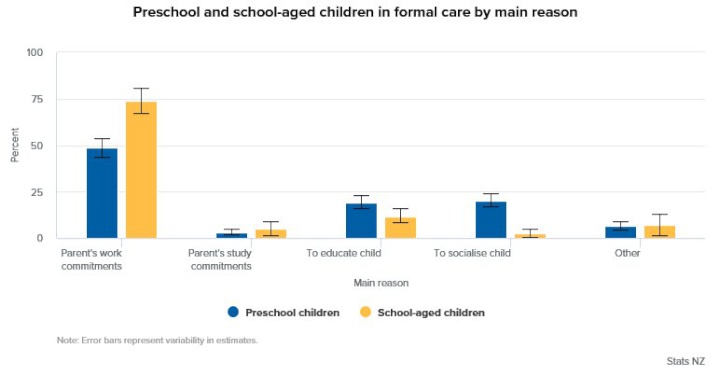1/2 of children in care due to parents' work arrangements
Parents’ work schedules and commitments were the
most-common reasons for children aged below 14 years to be
in formal childcare, Stats NZ said today.
Of the 282,500 children who attended formal childcare in 2017, more than half (56 percent) were there mainly because of their parents’ work arrangements.
“Parents are choosing to use formal childcare arrangements to make their work schedules possible. It is common for both parents to be working, and personally I can relate because my kids are in childcare for this reason too,” labour market and households statistics senior manager Jason Attewell said.
The Childcare Survey was run as part of the September quarter of the Household Labour Force Survey. Only parents who had children aged 13 or younger took part. From age 14, a child can legally be left without supervision.
The 2017 Childcare Survey showed that 64 percent of children aged four or under, and 15 percent of five- to 13-year olds attended formal childcare. Formal childcare covers a range of care and education providers including kindergartens, Kōhanga Reo, play centres, before- and after-school programmes, and homework centres and organisations which provide home-based care.
A child’s educational development was the second most-popular motivator behind parents choosing to use formal childcare, with 17 percent of children in formal care for this reason. An additional 15 percent of children were in formal care to socialise and mix with other children, and 4 percent because their parents were studying.
Reasons for using formal care varied between preschool and school-aged children. School-aged children were proportionately more likely to be in formal childcare because of parents’ work schedules. Work commitments were given as the main reason for nearly three-quarters (74 percent) of school children to be in formal care, compared with just under half (49 percent) of preschool children.'

The opposite was true for socialising and educating children, which were both more likely to be given as the main reason for preschool children to be in formal care. One in 5 preschool children (20 percent) were primarily in formal care to mix with other children compared with a considerably lower 2 percent of school-aged children. Education was the top reason for almost 1 in 5 preschool children (19 percent) and just below 1 in 8 (12 percent) of school children.
In 2017, 592,600 children below the age of 14 did not attend any sort of formal childcare. Of these children, 71 percent did not go because their parents preferred to look after them themselves. A further 12 percent of children did not attend because their parents preferred to have them looked after by family, friends, or older siblings instead.
Cost was a barrier for some, with 5.4 percent of children not attending any formal childcare because their parents found it too expensive.
The government has some initiatives in place to contribute towards the cost of formal childcare. Currently, the government funds up to 20 hours a week of early childhood education (ECE) for three- to five-year-olds who are not yet enrolled in school.
Of all the three- to five-year-olds who attended formal childcare in 2017, nearly 9 out of 10 (88 percent) used either some or all of the government funded hours. Sixty-two percent of children used the full 20- hour-a-week entitlement while only 4.5 percent used 10 hours or less.
More children are involved in the 20 hours of free ECE scheme now than they were eight years ago when the last childcare survey was conducted. In 2009, 81 percent of three- to five-year-olds in formal ECE used the funded hours.
The government also offers subsidies to help with the cost of formal childcare for low- and middle-income families. Slightly fewer parents are claiming these subsidies now than they were eight years ago. The number of children who used a subsidy decreased from 25 percent in 2009 to 17 percent in 2017.
Definitions and metadata
New Zealand Childcare Survey – DataInfo+ provides general methodology used to produce these statistics and related metadata, including definitions of concepts.


 Gordon Campbell: On bird flu, AUKUS entry fees and Cindy Lee
Gordon Campbell: On bird flu, AUKUS entry fees and Cindy Lee NZ Government: New Lab To Help Protect Key Pacific Tuna Fisheries
NZ Government: New Lab To Help Protect Key Pacific Tuna Fisheries Susan Botting - Local Democracy Reporter: Ruawai Leader Slams Kaipara Council In Battle Over $400k Property
Susan Botting - Local Democracy Reporter: Ruawai Leader Slams Kaipara Council In Battle Over $400k Property Te Pati Maori: Another ‘Stolen Generation’ Enabled By Court Ruling On Waitangi Tribunal Summons
Te Pati Maori: Another ‘Stolen Generation’ Enabled By Court Ruling On Waitangi Tribunal Summons Peace Action Wellington: Die In for Palestine Marks ANZAC day
Peace Action Wellington: Die In for Palestine Marks ANZAC day Labour Party: Penny Drops – But What About Seymour And Peters?
Labour Party: Penny Drops – But What About Seymour And Peters? Government: PM Announces Changes To Portfolios
Government: PM Announces Changes To Portfolios


